
Pleomele is a former genus of flowering plants. All its species are now placed in the genus Dracaena . [1] [2] [3] The Hawaiian name for plants in this genus is hala pepe, which translates to crushed or dwarfed Pandanus tectorius . [4]

Pleomele is a former genus of flowering plants. All its species are now placed in the genus Dracaena . [1] [2] [3] The Hawaiian name for plants in this genus is hala pepe, which translates to crushed or dwarfed Pandanus tectorius . [4]
Native Hawaiians combined the bark and leaves of hala pepe with the root bark of ʻuhaloa ( Waltheria indica ) and popolo ( Solanum americanum ), and a section of kō kea ( Saccharum officinarum ) to treat high fever and chills. Hala pepe bark, roots, and leaves were combined with ʻōhiʻa ʻai ( Syzygium malaccense ) bark, ʻuhaloa and popolo taproot bark, ʻalaʻala wai nui pehu ( Peperomia spp.) stems, noni ( Morinda citrifolia ) fruit, kō kea, niu (coconuts, Cocos nucifera), and pia ( Tacca leontopetaloides ) to treat lung disorders. [5]
The soft wood of the trunk was carved by Native Hawaiians into kiʻi . Hala pepe represented the goddess Kapo on the kuahu (altar) within a hālau hula (building which hula was taught or performed). It along with ʻieʻie ( Freycinetia arborea ), maile (Alyxia oliviformis), ʻōhiʻa lehua ( Metrosideros polymorpha ) and palapalai ( Microlepia strigosa ) were the five essential plants at the hula altar. [4]
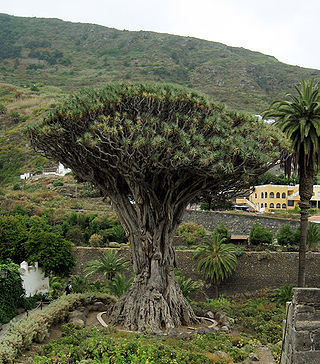
Dracaena is a genus of about 120 species of trees and succulent shrubs. The formerly accepted genera Pleomele and Sansevieria are now included in Dracaena. In the APG IV classification system, it is placed in the family Asparagaceae, subfamily Nolinoideae. It has also formerly been separated into the family Dracaenaceae or placed in the Agavaceae.
Located about 2,300 miles (3,680 km) from the nearest continental shore, the Hawaiian Islands are the most isolated group of islands on the planet. The plant and animal life of the Hawaiian archipelago is the result of early, very infrequent colonizations of arriving species and the slow evolution of those species—in isolation from the rest of the world's flora and fauna—over a period of at least 5 million years. As a consequence, Hawai'i is home to a large number of endemic species. The radiation of species described by Charles Darwin in the Galapagos Islands which was critical to the formulation of his theory of evolution is far exceeded in the more isolated Hawaiian Islands.
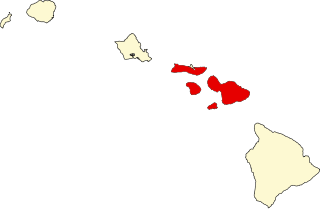
Maui Nui is a modern geologists' name given to a prehistoric Hawaiian island and the corresponding modern biogeographic region. Maui Nui is composed of four modern islands: Maui, Molokaʻi, Lānaʻi, and Kahoʻolawe. Administratively, the four modern islands comprise Maui County. Long after the breakup of Maui Nui, the four modern islands retained plant and animal life similar to each other. Thus, Maui Nui is not only a prehistoric island but also a modern biogeographic region.
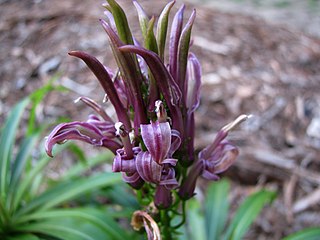
The Hawaiian lobelioids are a group of flowering plants in the bellflower family, Campanulaceae, subfamily Lobelioideae, all of which are endemic to the Hawaiian Islands. This is the largest plant radiation in the Hawaiian Islands, and indeed the largest on any island archipelago, with over 125 species. The six genera involved can be broadly separated based on growth habit: Clermontia are typically branched shrubs or small trees, up to 7 metres (23 ft) tall, with fleshy fruits; Cyanea and Delissea are typically unbranched or branching only at the base, with a cluster of relatively broad leaves at the apex and fleshy fruits; Lobelia and Trematolobelia have long thin leaves down a single, non-woody stem and capsular fruits with wind-dispersed seeds; and the peculiar Brighamia have a short, thick stem with a dense cluster of broad leaves, elongate white flowers, and capsular fruits. The relationships among the genera and sections remains unsettled as of April 2022.

Charpentiera is a flowering plant genus in the family Amaranthaceae. It consists of five species endemic to Hawaiʻi, where they are known as pāpala, and one species found only on the island of Tubuai in the Austral Islands. All species are trees, some reaching more than 10 metres (33 ft) in height. The genus is named for Arsène Charpentier (1781-1818), professor of pharmacy at Antwerp from 1810 to 1814 and at Cherbourg from 1814 to 1816.

Wikstroemia is a genus of 55-70 species of flowering shrubs and small trees in the mezereon family, Thymelaeaceae. Hawaiian species are known by the common name ‘ākia.

Acacia koaia, known as koaiʻa or koaiʻe in Hawaiian, is a species of acacia that is endemic to Hawaii. It is closely related to koa, and is sometimes considered to be the same species.

Mezoneuron kauaiense is a rare shrub or small tree in the genus Mezoneuron, that is endemic to Hawaii. Common names include uhiuhi, kāwaʻu (Maui), and kea (Maui). It is threatened by invasive species, particularly feral ungulates.

The Maui ʻalauahio, also known as the Maui Nui ʻalauahio or Maui creeper, is a species of Hawaiian honeycreeper. It is endemic to Maui Nui, Hawaii. The name Maui ʻalauahio is somewhat misleading because the species seems to have occurred on most, if not all, parts of the ancient Maui Nui, which includes the present day islands of Maui, Molokaʻi, Lānaʻi, and Kahoʻolawe. There are two subspecies: the Lānaʻi ʻalauahio, P. montana montana, which occurred on Lānaʻi (extinct); and P. montana newtoni which occurs on Maui. The common name refers to both groups.
Kokia kauaiensis, the Kauai treecotton or Kauaʻi Kokiʻo, is a species of flowering plant in the mallow family, Malvaceae, that is endemic to Kauaʻi, Hawaii.

Cibotium menziesii, the hāpuʻu ʻiʻi or Hawaiian tree fern, is a species of tree fern that is endemic to the islands of Hawaiʻi. It is named after the Scottish naturalist Archibald Menzies. It is also known as the male tree fern, and Cibotium glaucum is deemed the female tree fern due to differences in color.
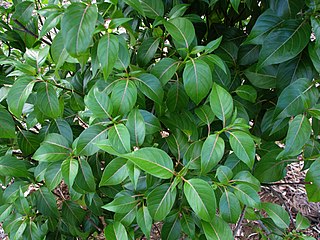
ʻAhakea or Hawaiʻi dogweed is a species of flowering tree in the coffee family, Rubiaceae, that is endemic to Hawaiʻi. It inhabits lava plains as well as dry, coastal mesic and mixed mesic forests at elevations of 100–1,220 metres (330–4,000 ft) on the islands of Oʻahu, Molokaʻi, Lānaʻi, and Maui. It is threatened both by habitat loss and competition from invasive species.
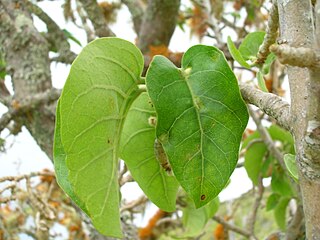
Nothocestrum is a genus of flowering plants in the nightshade family, Solanaceae. It contains four species of large shrubs or small trees that are endemic to Hawaii, where they are known as ʻaiea.

Dracaena rockii, synonym Pleomele auwahiensis, commonly known as maui hala pepe, is a species of flowering plant that is endemic to the islands of Maui and Molokaʻi in Hawaiʻi. It can be found in dry and mesic forests at elevations of 610–1,220 metres (2,000–4,000 ft). It is threatened by habitat loss.

Dracaena fernaldii, synonym Pleomele fernaldii, is a species of flowering plant that is endemic to the island of Lānaʻi in Hawaiʻi. It is known by the common name Lanai hala pepe. It can be found in dry forests at elevations of 490–670 metres (1,610–2,200 ft). It is threatened by habitat loss. 400–1000 of these plants remain in the wild, but little recruitment has been observed in the past 10 years. The reasons for the lack of recruitment are unclear.
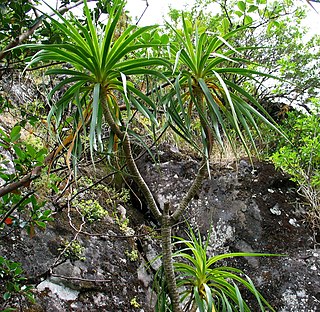
Dracaena forbesii, synonym Pleomele forbesii, is a species of flowering plant that is endemic to the island of Oʻahu in Hawaiʻi. It inhabits dry, coastal mesic and mixed mesic forests at elevations of 240–730 metres (790–2,400 ft). It is threatened by habitat loss.

Dracaena halapepe, synonym Pleomele halapepe, the royal hala pepe, is a species of flowering plant that is endemic to the island of Oʻahu in Hawaiʻi. It inhabits dry, coastal mesic and mixed mesic forests at elevations of 180–610 metres (590–2,000 ft). It is threatened by habitat loss.

Santalum freycinetianum, the forest sandalwood, Freycinet sandalwood, or ʻIliahi, is a species of flowering tree in the European mistletoe family, Santalaceae, that is endemic to the Hawaiian Islands. Its binomial name commemorates Henri Louis Claude de Saulces de Freycinet, a 19th-century French explorer. ʻIliahi inhabits dry, coastal mesic, mixed mesic, and wet forests on Oʻahu, Kauaʻi, Lānaʻi, Maui, and Molokaʻi at elevations of 250–950 m (820–3,120 ft). It grows in areas that receive 500–3,800 mm (20–150 in) of annual rainfall. Like other members of its genus, ʻiliahi is a root hemi-parasite, deriving some of its nutrients from the host plant; common hosts include koa, koaiʻa, and ʻaʻaliʻi.
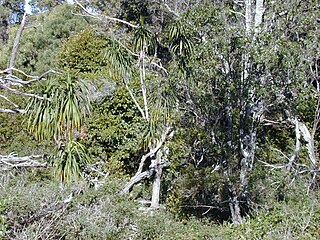
Dracaena aurea, the golden hala pepe, is a species of flowering plant that is endemic to the island of Kauaʻi in Hawaii. It inhabits coastal mesic and mixed mesic forests at elevations of 120–1,070 m (390–3,510 ft). It is a small evergreen tree, usually 4.6–7.6 m (15–25 ft) tall, but sometimes reaches 12 m (39 ft). The gray, straight trunk does not have bark and is 0.3–0.9 m (0.98–2.95 ft) in diameter. The sword-shaped leaves are 20–51 cm (7.9–20.1 in) long and 1–3 cm (0.39–1.18 in) wide.
Drosophila obatai is an endangered species of fly from Hawaii, in the species rich lineage of Hawaiian Drosophilidae. It is only found on the island of Oahu. D. obatai is part of the orphnopeza subgroup in the picture-wing clade, and is closely related to D. sodomae, a fly found on the islands of Maui and Molokai.